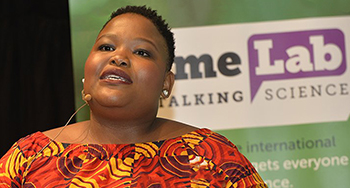
UFS researcher nabbed a top international award for
her ground-breaking metallurgical research in the UK.
Photo: Supplied
Recently, University of the Free State (UFS) Centre for Environmental Management master’s student, Tshiamo Legoale, was announced the FameLab International champion at the Cheltenham Science Festival in the United Kingdom. She is probing methods to use wheat as a gold hyper-accumulator – or, as she puts it, “grow gold from wheat”. The young researcher made South Africa proud by winning both the audience’s and the judges’ vote.
Coming back home a hero
“Winning was a surprise to me, because all 31 contestants had wonderful research. They all had really good presentations. I’m very grateful for all the support that I received from home. Social media showed me a lot of love and support. When I felt unconfident, they gave me ‘likes’ and that boosted my confidence a bit,” said Legoale about her win.
As South Africa celebrates Youth Month in June, Tshiamo represents hope for thousands of young South Africans to overcome difficult circumstances and follow careers in science.
The human impact is crucial, because Legoale’s win is not only scientific. It is also social and political. As a young female scientist in South Africa, she represented one of three African countries making it to the finals of FameLab, which has grown to one of the largest science communication competitions internationally.
With this in mind, Legoale says it may, in the end, be necessary to balance the needs of communities with the desire to increase yield. “Are we looking to make a fortune or are we looking to put food on the table?” she asks. “These are all things we consider when we conduct such research.”
World-class research from Africa
In South Africa, an estimated 17.7 million tons of gold is wasted. “All this gold was mined out previously, but tiny amounts remain in the dumps,” Legoale explains.
Her research focuses on the uses of wheat as a gold hyper-accumulator, which essentially means wheat plants are used to harvest gold from mine dumps. Simply put, the wheat is planted in the dumps, where enzymes found in the roots react with the gold and the plant absorbs it. The gold is then absorbed by every part of the plant, except the seeds, which means the next harvest can be used for food if need be.
“South Africa's world-champion young scientist, Tshiamo, represents all that is good about this country – brilliant, bright, and set for a fine future. I'm so proud that British Council SA, together with our partners SAASTA and Jive Media Africa, can help her along the way. Huge congratulations to her from all of us – it is a big win for Africa on the world stage,” said Colm McGivern, British Council South Africa Country Director.
The research represents a win on multiple levels. First, there are the obvious potential socio-economic benefits: food production, job creation, and phytomining is more economical than other contemporary mining methods.
Then there is safety. It is a more environmentally friendly practice than methods like heap leaching, carbon-in-leach or carbon-in-pulp. It is also safer for miners themselves, who will not be exposed to dangerous chemicals like mercury, which has been responsible for a great deal of toxicity in mine dumps. And it is safer for those living in the surrounds.